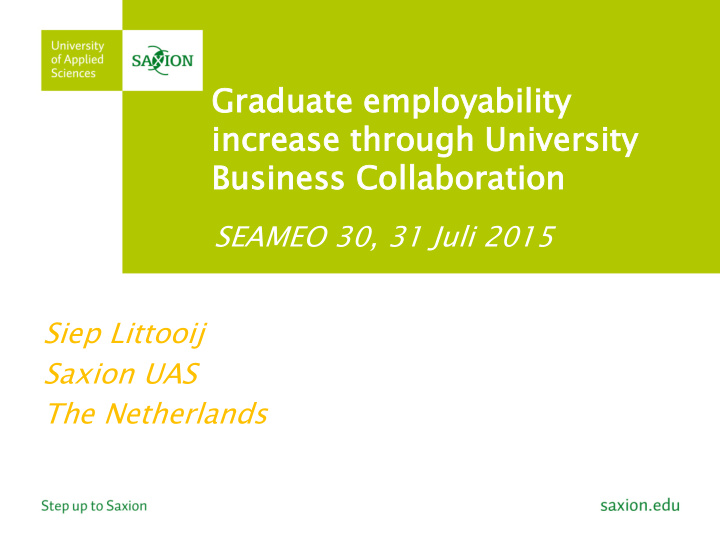



Gradua uate emplo loya yabilit ility incr crea ease throug ugh Unive iversi sity Business Colla llaboratio ion SEAMEO 30, 31 Juli 2015 Siep Littooij Saxion UAS The Netherlands
Quality of students • Quality of students: traditional measure – academic performance – Process, e.g. accreditation • Quality of students: NOW – The performance of graduates on the labour market. – The contribution of students to innovation • Student quality as seen through the eyes of business as (future) employers • Higher Education Institutions need to deliver the right kind of graduates to the labor market.
Quality through the eye of business Graduates lack the skills needed to succeed in today’s • market: – Critical and creative thinking skills – Teamwork abilities – Communication skill, – Command of foreign languages – ICT skills These skills are needed more than ever • – to improve productivity and competitiveness, especially in the manufacturing sector, – to respond to the needs of the growing service sector Higher education has a critical function in supplying • employees with: – higher–level academic knowledge – technical skills – behavioral skills
Monitoring student success in the Netherlands, Saxion UAS • Annual, national student satisfaction survey • Annual, national HBO Monitor • Programme specific Tracer studies Figure 1 Graduates Employed NL, per timeblock after graduation
Graduate tracer studies in Vietnam • Tracer studies mirrored to Dutch monitoring systems • Show that universities where curriculum development is done in collaboration with enterprise, show a jump in employability. 54 , 5% 27 , 3% MOET: Among100 1-3 months universities in Vietnam 122 , 11% 3-6 months 476 , 44% students employment rate 6-12 months 12+ ‘a ‘appro pproximately ly 50 50%’ (a job 397 , 37% no data within 3 months after 8 POHE programmes graduation) 2007-2013 (N=1360)
Call for policy making for stakeholders, rectors and deans. • What to do? – Improve understanding of business/labour market needs – Curriculum reform to incorporate more competencies • Approaches – Educational improvements – Improve exposure of students and business – Improve relations between university and businesss Logical and knowledgable policy making: the theory of University Business Collaboration (UBC)
The University Business Collaboration (UBC) model 8 Results: Measurable UBC Collaboration in research and • development (R&D) Mobility of academics between • business and university Mobility of students between • business and university Commercialisation of R&D • Findings Curriculum development and • delivery Lifelong learning (LLL) • Entrepreneurship • Governance •
Co-creation’: A wide array of educational approaches • Driver of Saxion ‘co-creation’. – Advance the moment in the curriculum that student competencies are developed with and judged by business – Increase business benefits from UBC. The design variables, e.g. : amount and type of professors/lecturers involvement • • teaching process/ style, engagement • control of the involved group composition/size • • student maturity companies over the • assignment and outputs. disciplines/multidisciplinarity • Costs assignment output, reality level, • • staff engagement, etc, etc. Location • Duration • Location • Costs •
Figure 4 Co-creation formats Saxion
Vietnam: policies and realisation of UBC; the views from stakeholders 2014 2. Third parties POHE2: Bên th ứ 3 Learn o Teach o Teaching Policies o Policy Regulations o Mechanisms 3. Universities 1. Business Trư ờ ng ĐH Doanh nghi ệ p 2013 2015
Study 2013 1. VN Business preparedness to collaborate with universities • UBC is a rather unknown concept • student mobility recognized! Number o r of enterpr rpris ises % of of tota total Type o Typ of U UBC C Re Result repo port rtin ing t to part rticip ipate comp ompanies 1. 1. Colla llaboration in in re research a and d 5 3% develo lopm pment ( (R&D) D) 2. 2. Mobilit lity o of acade demic ics b between 13 8% bus usine ness a and nd uni university 3. 3. Mob obility of of stu tudents ts b betw tween business 107 63% and nd uni university 4. 4. Commerc rcia ialis lisatio ion o of R R&D Findin ings 3 2% 5. 5. Curric riculu lum d develo lopm pment a and deliv ivery ry 80 47% 8. 8. Governan ance ce 4 2% A learned lesson is that when University Business Collaboration is found, it generates spin-off effects on both sides.
Study 2014 2. The 3 rd side: Vietnamese state as UBC stakeholder Analysis: UBC occasionally mentioned in high level legal • framework in the three fields of 1/ higher education, 2/ science and 3/ technology and enterprise management Missing implementation level regulations, therefore little • happens For what there is, dissemination activities are not • effective; No supervision, monitoring or management of UBC. • Bottleneck is lack of Statistics and information on labor • market Conclusions The state role is rather invisible or not fully deployed • Business and universities are left largely to themselves. •
Study 2015 3. Vietnamese University collaboration with business • Online study N= 350 – Managers identify collaboration, influencing – Researchers factors and mechanisms. – Non-researching academics (results forthcoming July 2015)
Thank you Contacts • POHE project: Pohevn.grou.ps • Saxion UAS: www.saxion.nl/ www.saxion.edu Email : s.l.littooij@saxion.nl • Save the Date: Webinar 8 October 2015 References Reports downloadable from POHE projectsite • http://www.ub-cooperation.eu • http://go.worldbank.org/FF185GEZI0 •
Recommend
More recommend